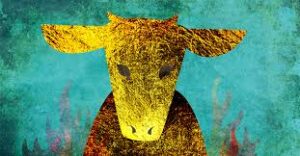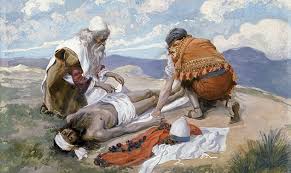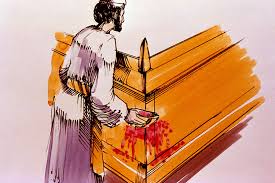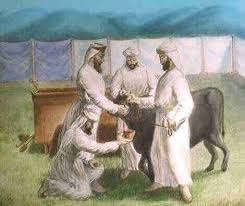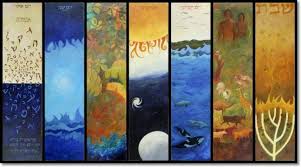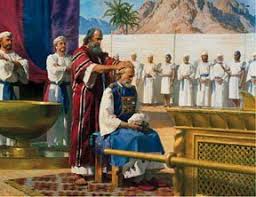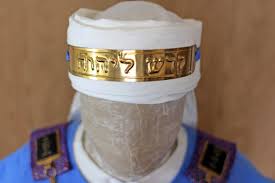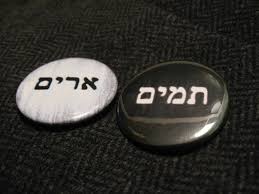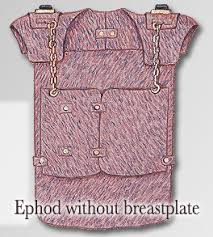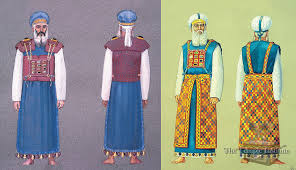Gr – Aaron Made an Idol in the Shape of a Calf 32: 1-6
Aaron Made an Idol in the Shape of a Calf
32: 1-6
Aaron made an idol in the shape of a calf DIG: How long had Moses been up on Mount Sinai? What was the attitude of the people toward him? Where do you think the former slaves got their gold earrings? Why did they say gods, plural? Who led the Israelites out of Egypt? What did Moses see when he came down carrying the Ten Commandments?
REFLECT: What is the golden calf in your life? What is standing between you and God? Spouse? Children? Parents? Computer? Sports? Music? God doesn’t want anything between Him and you! Has service for the King, replaced the King in your life?
While Moses was experiencing intimate fellowship on the top of Mount Sinai with God, the people were rebelling at the foot of the mountain with Aaron. One gets the impression, from these verses, that the people had decided among themselves that Moses had abandoned them, had been killed, or that his behavior did not serve their needs or desires. In light of this, they decided to take matters into their own hands.658
The people saw that Moses was so long in coming down from the mountain. The word for so long comes from a verb that normally means to be ashamed. It may mean that the people had been put to shame, because they felt Moses had left them and had not returned. So the people gathered around Aaron. The use of the verb gathered, with the preposition around often conveys a sinister intent; these people were rebellious in spirit (see Numbers 16:3, 42, 20:2 for other examples of the same construction). The demand that they made of Aaron was menacing: Come make us gods who will go before us. They needed a visible, tangible object to follow. Right away they lapsed into idolatry.659 As for this fellow Moses who brought us up into Egypt, we don’t know what has happened to him (32:1). The rabbis teach that Satan caused the Israelites to see a bier, or a table on which a casket or corpse is placed, passing across the skies on which a figure resembling Moses, which confirmed their conclusion that he was dead. It was very strange that after seeing all the miracles of the ten plagues, that they had those kinds of thoughts. They had already forgotten that it wasn’t Moses who parted the Red Sea.
You would think Aaron, who was the high priest, would try to stop them. Unfortunately, he had already forgotten what the Torah said: Do not follow the crowd in doing wrong (23:2). He went along with them and said: Take off the gold earrings that your wives, your sons and your daughters are wearing, and bring them to me. This was probably the plunder they acquired from the Egyptians on the day of the exodus (12:35-36). So all the people took off their earrings, which may have been part of the plunder from Egypt, and brought them to Aaron (32:2-3). Both Stephen (Acts 7:39-41) and Paul (First Corinthians 10:6-7) remembered Aaron’s sinful submission to the wishes of the crowd as an example of willful disobedience.

He took what they handed him and made it into an idol cast in the shape of a calf. The calf was probably intended to represent one or more of the visible forms of the Egyptian bull-god Apis (to see link click Bo – The LORD Will Bring a Terrible Plague on Your Livestock in the Field), fashioning it with a tool. Then they said: These are your gods, O Isra’el, who brought you up out of Egypt (32:4). Worse still, they blasphemed God’s name by claiming that neither God nor Moses had brought them up out of Egypt but that the calf had done so.660 The plural word gods may be confusing, because there was only one bull-calf made. This may actually be a reflection of syncretism, or the thought that all paths lead to God, in which the calf was seen as being in partnership with God. It was obvious that Isra’el had failed to learn the lesson of the ten plagues of Egypt. They failed to learn the lesson of the uselessness of idolatry and that failure to learn it, had corrupted their faith. Therefore, they refused to obey Moses. Instead, they rejected him and in their hearts turned back to Egypt (Acts 7:39). They exchanged the truth of God for a lie and worshiped an idol that ate grass rather than the Creator of the universe (Romans 1:25).
King Jeroboam, the first king of the northern kingdom of Isra’el, made the same mistake. He also made two golden calves and uttered the same words to the people: Here are your gods, O Isra’el, who brought you up out of Egypt (First Kings 12:28b). And throughout Isra’el’s history there will always be that dichotomy, the constant threat of a new religion (like Ba’al), or the corruption of the true religion (like worshiping the golden calf).
Not only did Aaron build the golden calf, but he also built an altar and put it in front of the people. When Aaron saw this, he built an altar in front of the calf and announced: Tomorrow there will be a festival to God (32:5). The fact that the Jews were engaged in syncretism is confirmed by Aaron’s proclamation that the next day would be a festival to ADONAI. The Hebrews were falling prey to polytheism, and in doing so had violated the first two commandments of the Torah that God had given them. They didn’t realize that instead of all paths leading to God, God would travel any path to get to them.
So the next day the people rose early and sacrificed burnt offerings and presented peace offerings. Afterward they sat down to eat and drink and got up to indulge in revelry (32:6). These were the very same offerings that ADONAI had commanded the Jewish people bring Him on an altar of earth earlier (20:24). This is another confirmation that some form of syncretism was taking place at the foot of Mount Sinai. The Psalmist described it like this: At Horeb they made a calf and worshiped an idol cast from metal. They exchanged their Glory for an image of a bull that eats grass. They forgot the God who saved them, who had done great things in Egypt, miracles in the land of Ham and awesome deeds by the Red Sea. So He said He would destroy them – had not Moses, His chosen one, stood in the breach before Him to keep His wrath from destroying them (Psalm 106:19-23).
It was not surprising that after they sacrificed offerings to Aaron’s calf, the people began to indulge in pagan revelry, which violated the seventh commandment (20:14). Throughout biblical times idolatry was frequently carried on in connection with all kinds of immorality (Galatians 5:19-21; First Peter 4:3).660 Basically, when Moses came down from Mount Sinai he saw an orgy.
Isra’el has served false gods in Egypt (Joshua 24:14), and their flesh was unchanged. It was true that God had made redemption possible for them. But sadly, most were still a perverse generation without faith (Deuteronomy 32:20). So when reading their history we must never forget that we should flee sexual immorality (First Corinthians 10:8a and 14). So, to, John would say: Little children, keep yourself from idols. May God grant us the wisdom to heed his solemn warnings. There is only one way of escape, be constantly occupied with Jesus Christ.
Today we need to learn this lesson. Moses was away from Isra’el, up the mountain; Messiah is away from the earth, seated at the right hand of the Father. But before He went away He said to His disciples: Trust in God; trust in Me also (John 14:1). He is the object of our faith, and it is only as our affections are set upon Him, as we are in daily communication with Him, that our hearts are kept from idols. But just as surely as Isra’el’s turning away from God was at once followed by the making of the gold calf, and just as surely as believers have lost their first love (Revelation 2:4), so today, divorcing our hearts from Messiah opens the door to the sin of idolatry.661 Stay close to Him.



